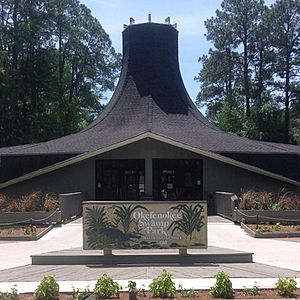Okefenokee Swamp Park facts for kids
The Okefenokee Swamp Park is a special place in Georgia, United States. It's about 12 miles south of Waycross. This park is the main way to get into the northern part of the Okefenokee National Wildlife Refuge. The Okefenokee Swamp is the largest blackwater swamp in North America. It covers a huge area of over 438,000 acres!
Contents
Okefenokee Swamp Park: Explore Nature!
The Okefenokee Swamp Park is managed by a group called the Okefenokee Association, Inc. This group is a private nonprofit organization. Their main goal is to help people learn about nature and visit the Okefenokee Swamp. Millions of people from all over the world have visited the park since it opened in 1946.
History of the Park
The park started using and improving paths that were already there. These paths were first made by Native Americans. Later, in the 1930s and 1940s, workers from the Civilian Conservation Corps built more structures and boardwalks. One of these boardwalks led to a 75-foot wooden tower.
In 1965, the wooden tower was replaced with a taller, 90-foot steel tower. This new tower became the highest point for viewing the swamp. It gives visitors an amazing aerial view of the Okefenokee.
Many new buildings and features were added to the park in the 1970s. These included a new Gift Shop in 1970 and Pioneer Island in 1971. A new boat dock, the Swamp Creation Building, and the Living Swamp Building were added in 1972. The Serpentarium/Nature Center opened in 1974, and the Country Store in 1975. An outdoor stage was built in 1981, and a Wetlands Exhibit in 1990.
In 1999, a special railroad system opened at the park. It's the only one allowed in the Okefenokee National Wildlife Refuge. This train takes visitors on a 1.5-mile trip through the swamp. It reminds people of a time long ago when loggers and other workers were busy in the swamp.
What Can You Do There?
Visitors to the Okefenokee Swamp Park can enjoy many activities:
- Take boat tours through the swamp.
- Walk along long nature boardwalks.
- Watch exciting wildlife shows called "Eye on Nature."
- See live animals up close in exhibits.
- Learn about wildlife and the local culture through different displays.
Pioneer Island and History
One interesting stop on the train ride is Pioneer Island. Here, you can see a recreated swamp homestead. It has an old cabin, called the Highsmith Cabin, and other important buildings from the past.
The Country Store also acts as a museum. It shows old photos and many items that tell the story of the Okefenokee Swamp and the park. There's also a replica of the Wildes Cabin on Pioneer Island. This cabin is a memorial to Maximillian Wildes and others who died in 1838. This event was the last Native American massacre in Georgia. The memorial was dedicated in 1988.
A famous alligator named Oscar lived at the Okefenokee Swamp Park until he passed away in 2007. You can see his reconstructed skeleton on display in the Gift Shop.
Supporting the Park
There is an admission fee to enter the park. This money helps to run and improve the park. People also donate their time and money to the park, especially members of the Osprey Society.
While you can't camp overnight at the Okefenokee Swamp Park, there are camping spots nearby at Laura S. Walker State Park.
Images for kids





